We Tested 7 Clay Alternatives and Competitors for Data Enrichment in 2025
When I first tried Clay, it felt like the answer.
Pull leads, enrich data, build workflows no code, just results.
But a few weeks in, I hit a wall.
⚠️ It was slow to set up.
⚠️ Hard to learn.
⚠️ And every new workflow burned through credits fast.
It went from “this is awesome” to “why am I paying so much just to get a list?”
So I did what most people don’t:
I tested 7 other tools myself.
Signed up. Pulled real B2B leads. Checked how accurate the data was.
Measured how fast I could go from filters → to list → to outreach.
If you're in sales, marketing, or just trying to get better leads faster—this blog is for you.
Here's what you're getting:
✅ What Clay does well and where it breaks down
✅ 7 real alternatives I tested (not just listed)
✅ What worked better, what didn’t, and how they compare to Clay
✅ Honest pros, cons, pricing, and who each tool is best for
✅ A simple breakdown to help you pick the right one without wasting time
If you’re spending too much time or money on Clay, this blog will help you find a better option.
This guide covers the best clay alternatives, highlighting the top options, their features, and how they compare to Clay so you can choose the right tool for your needs.
Let’s begin.
Clay vs 7 Alternatives: Quick Comparison
What We Looked for in a Clay Alternative
Before testing, I made a short checklist of what really matters for B2B data enrichment.
Clay is powerful but not always easy. So I looked for tools that could do the job faster, simpler, and with less setup.
Here’s what I checked during testing:
✅ Speed to Set Up: I didn’t want a tool that takes hours to figure out. It should work within minutes, not days. Tools with automated workflows were prioritized, as they streamline both setup and execution.
✅ Lead Enrichment Quality: I looked for clean, updated leads with real job titles, LinkedIn profiles, company size, and more.
✅ Built-in Outreach: Some tools also let you send emails or sync to CRMs. That’s a big win—no switching between tools.
✅ Pricing Transparency: I wanted clear pricing with no surprise costs or hidden limits. Tools that charge per “action” get tricky fast.
✅ Ease of Use: I picked tools that anyone can use, without needing a developer or writing code. A user friendly interface was a key factor in this evaluation, making navigation and operation much easier.
✅ Who It’s Best For: Each tool fits a different type of user. I made sure to note who it’s good for—whether you’re doing cold outreach, running an agency, or just starting.
If a tool checked most of these boxes, it made my shortlist. Platforms offering data-driven insights were also favored, as they help optimize outreach and sales processes through advanced analytics.
Let’s break them down one by one.
5 Clay Alternatives and Competitors for Data Enrichment in 2025
Clay is powerful, no doubt. It can pull data from dozens of sources, enrich it with APIs, and build advanced lead workflows.
But after using it for a while, I started wondering:
Is there a simpler or faster way to get enriched leads without all the setup?
That’s why I spent a few weeks testing real alternatives. I didn’t just look at features — I signed up, ran lead tests, and tried to build actual outbound flows. In my evaluation, I also considered whether each option functions as a comprehensive sales engagement tool, combining outreach, enrichment, and analytics.
Here’s a full side-by-side comparison of how each tool performed against Clay during our testing: This section will help you identify the best clay alternative for your specific needs by comparing data accuracy, features, automation, and integration options.
🔄 Clay vs All 5 Alternatives – Real Testing Summary
1. Leadsforge – The Fastest Tool We Tested
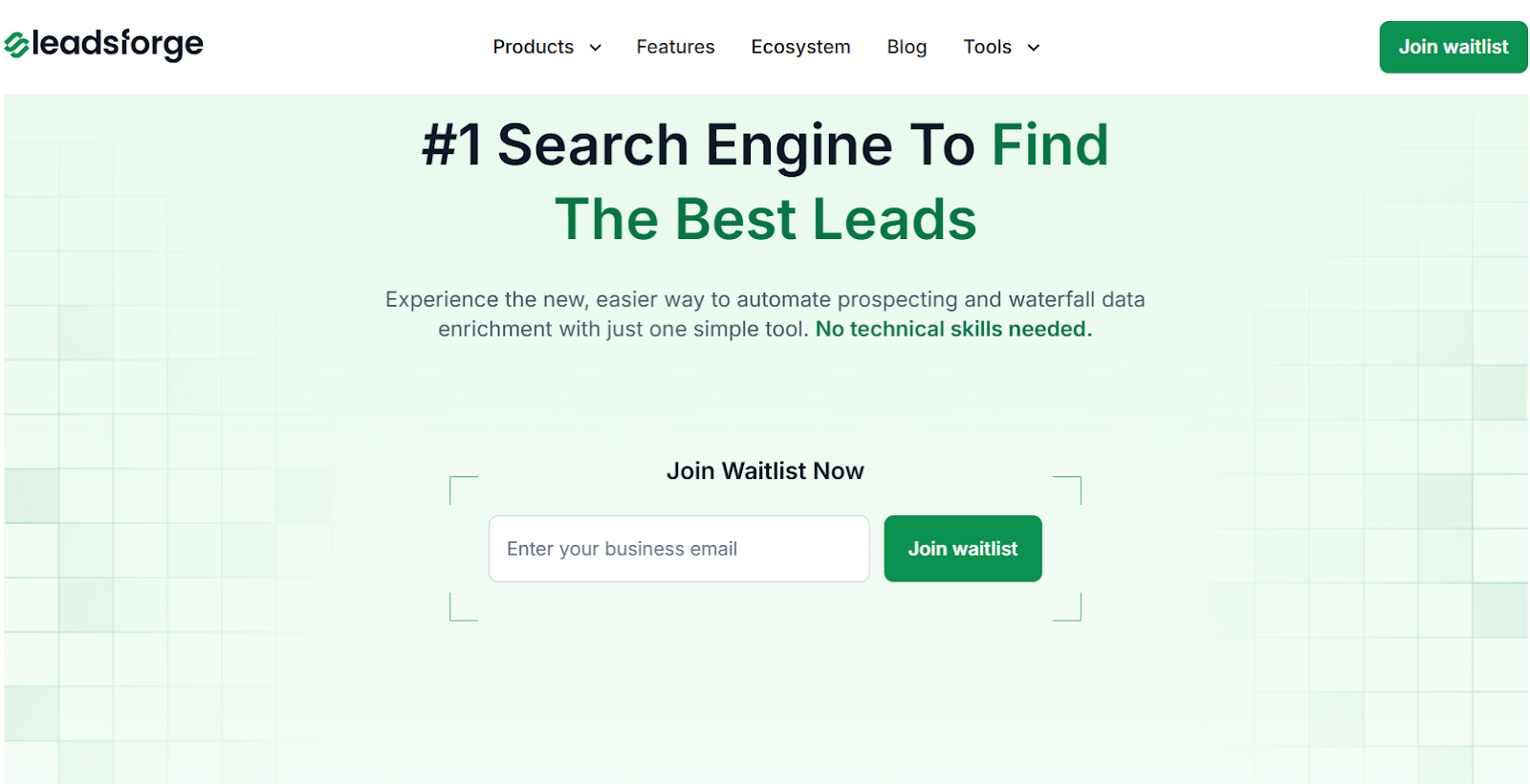
When I started testing tools to replace Clay, Leadsforge was the first one. I wanted to see if it could give me clean, enriched leads without all the setup Clay needs.
With Clay, I had to build a full workflow just to pull leads and enrich them. It worked—but it took time.
So I signed up for Leadsforge to see if it could do the same thing, faster.
Here’s what happened.
- I created an account, selected a target group (I chose SaaS founders in the U.S.), and hit start.
- In less than 10 minutes, I had a full list of leads—already enriched with job titles, company size, and even funding details. Leadsforge also helps verify contact details such as emails and phone numbers to ensure outreach accuracy. Additionally, it leverages data from company websites to enhance lead profiles and provide more accurate information.
- It was simple, fast, and didn’t require any technical steps to get usable results.
Leadsforge uses a credit based pricing model, similar to Clay. Like other tools with this approach, you pay per lead or enrichment, which can be confusing or add up in cost for small teams.
If you’re looking to generate clean B2B lead lists quickly, Leadsforge is one of the smoothest tools out there.
✅ What Worked Well with Leadsforge:
- Leads are accurate and enriched right out of the box
- I saved at least 2–3 hours per campaign compared to Clay
- Built-in filters (industry, revenue, etc.) helped narrow down better-fit leads
- Leads are ready to export in under 15 minutes
⚠️ What’s Missing in Leadsforge:
- You can’t build multi-step workflows like Clay
- No advanced automations or custom logic
But honestly, if your goal is fast lead generation, you won’t miss those features.
💰 Leadsforge Pricing:
Starts at $49/month with a simple credit-based system, no setup fees or confusing automations like Clay.
Leadsforge also offers a basic access plan, which includes essential features and limited data availability for users who need only the core functionalities.
If you’re short on time and just want quality leads you can use now, Leadsforge is much faster and easier than Clay.
It may not be as flexible, but for sales teams and agencies who care about speed, it’s a huge time-saver.
Let’s move to the next tool: Apollo.io.
2. Apollo.io – Better Than Clay If You Want a Huge Lead Database
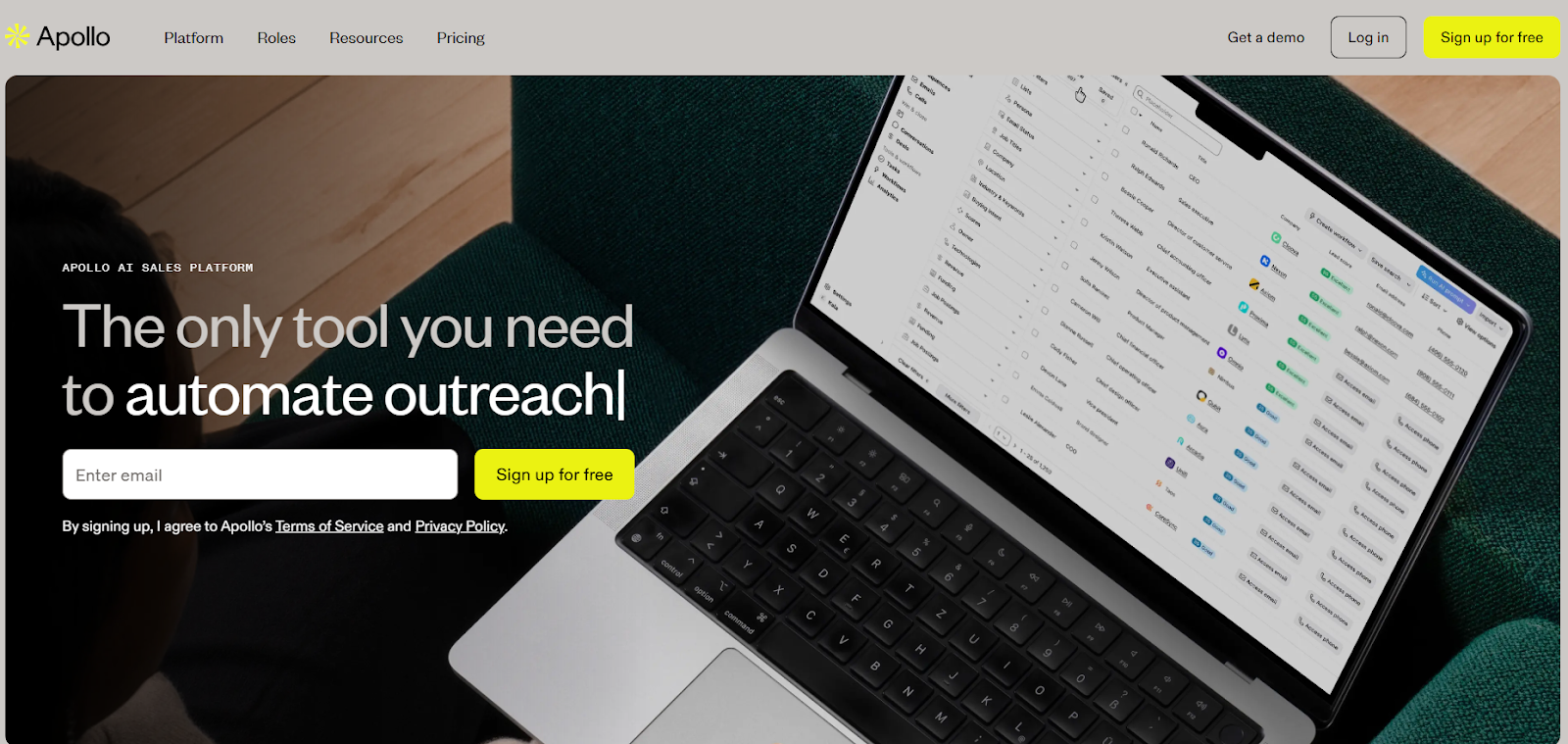
After trying Leadsforge, I moved on to test Apollo.io.
Apollo.io is a sales engagement platform that streamlines multi-channel outreach and automates repetitive sales tasks for sales teams.
It is known to offer a vast database of B2B contacts, making it one of the biggest B2B lead databases out there, so I wanted to see how Apollo.io performs compared to Clay.
Clay lets you build smart workflows and pull data from different tools. But the lead data itself depends on which sources you connect.
With Apollo, the leads are already there. You don’t need extra blocks or APIs. Apollo.io also enables prospecting and lead sourcing directly from LinkedIn and company websites, enhancing the quality and relevance of its database.
In summary, Apollo.io also functions as a sales intelligence tool, providing valuable insights and automation for outbound sales.
✅ What I Liked While Testing Apollo.io:
- I could search from millions of contacts using filters like job title, industry, location, company size, and revenue
- Most leads came with LinkedIn profiles, emails, job titles, and phone numbers
- Apollo.io is available as a web app, making it easily accessible from any browser
- I built a cold outreach sequence (email + LinkedIn view) inside Apollo itself
- It also lets me sync the leads directly to HubSpot without needing Zapier or other tools

⚠️ What’s Missing in Apollo.io:
- The platform has a lot of features — it felt heavy at first
- Some emails and phone numbers were outdated (not many, but I noticed it)
- Many advanced features (like automation and scoring) were locked in higher plans

💰 Apollo.io Pricing:
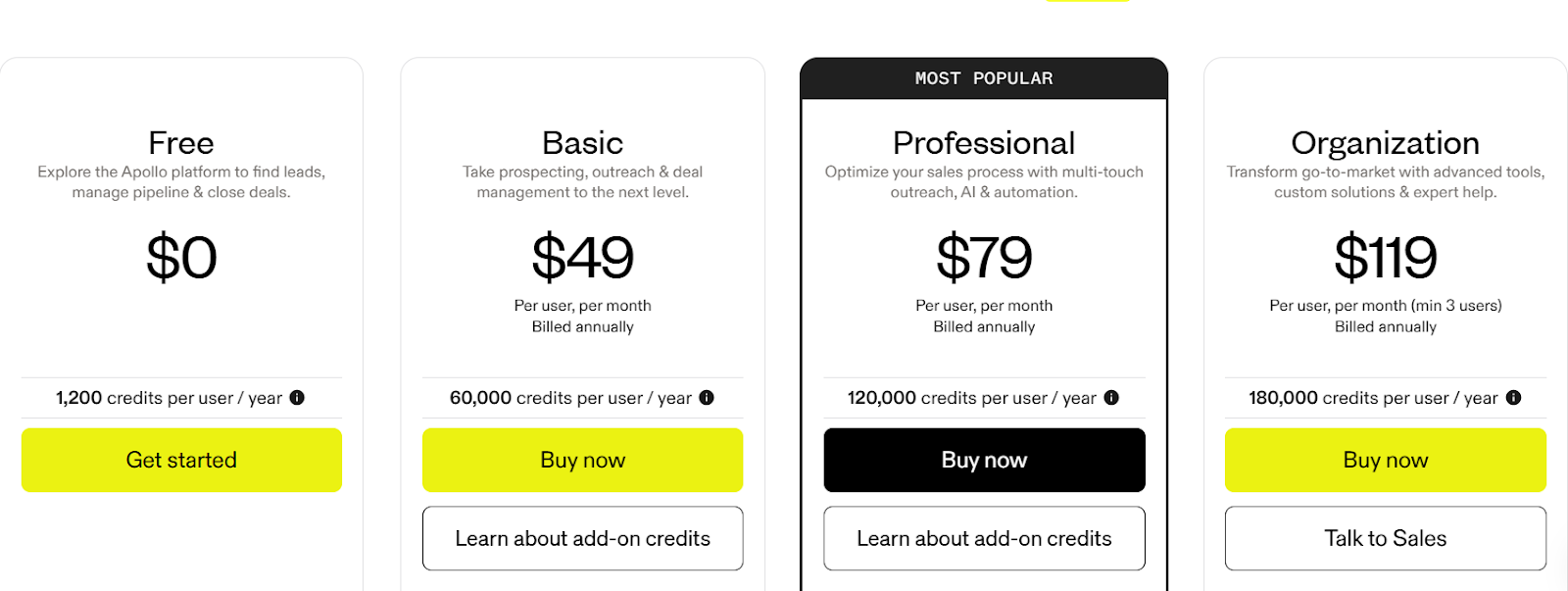
- Free Plan – $0/month (limited credits)
- Basic Plan – $49/month per user
- Professional Plan – $79/month per user
- Organization Plan – $119/month per user
Apollo.io offers multiple paid plans to suit different business needs, providing options for various team sizes and feature requirements.
Discounts are available with annual billing.
Apollo is a good Clay alternative if your main goal is to find a lot of leads fast and run outreach from one place.
If you don’t want to deal with enrichment blocks and API setups, Apollo gives you a complete database and ready-to-use tools.
Let’s look at the next one: Instantly.
3. Instantly B2B – Fast, Clean, and Outreach-Ready
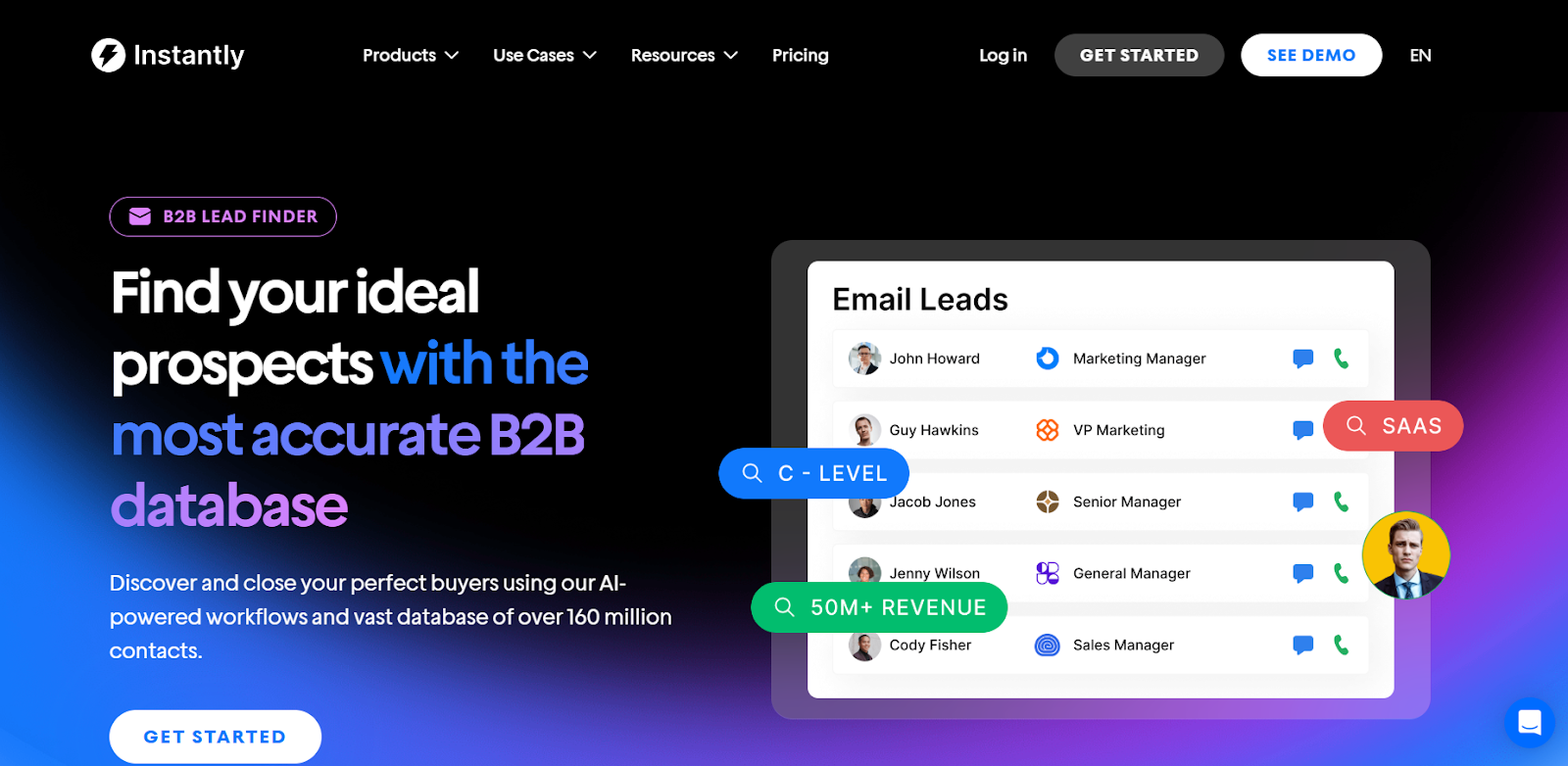
After testing Leadsforge and Apollo, I wanted to try something even simpler.
That’s when I tested Instantly B2B.
Instantly is built for one thing: getting leads and sending cold emails fast. It’s not as complex as Clay, but that’s actually the point.
With Clay, you can do deep enrichment if you connect different tools. But it takes time.
With Instantly, you get verified B2B leads + email sending in the same place—no setup pain. If you use their chrome extension, you can prospect and enrich data directly from LinkedIn or other platforms for even faster lead generation. However, Instantly B2B does not support bulk data enrichment, which may be a limitation for teams needing to process large volumes of leads.
✅ What I Liked While Testing Instantly:
- I signed up and pulled 1,000 leads in under 10 minutes
- Leads came with comprehensive contact details such as emails, job titles, LinkedIn URLs, and company info
- It has built-in cold email sequences + warmup, so I didn’t need to export anything
- The dashboard was super clean—no clutter, no confusion

⚠️ What’s Missing in Instantly B2B:
- It’s not built for deep enrichment like Clay (no AI workflows or multi-source pulls)
- CRM syncs like Pipedrive worked, but needed a little manual setup
- Only supports email, not LinkedIn steps or multi-channel like Apollo

💰 Instantly Pricing (2025)

- Growth Leads Plan – $47/month
- Supersonic Plan – $97/month
- Hyperleads Plan – $197/month
- Light Speed Plan – $492/month
Pricing is based on the number of leads per month. No free plan available. Custom pricing is available for larger teams or enterprise clients with specific needs.
If you’re running cold outreach and want speed + simplicity, Instantly is a solid Clay alternative.
It’s not for custom workflows, but if you just need leads + email in one tool, it does the job really well.
Next up, I’ll cover Smartlead.
4. Smartlead – Deliverability First, Simplicity Second
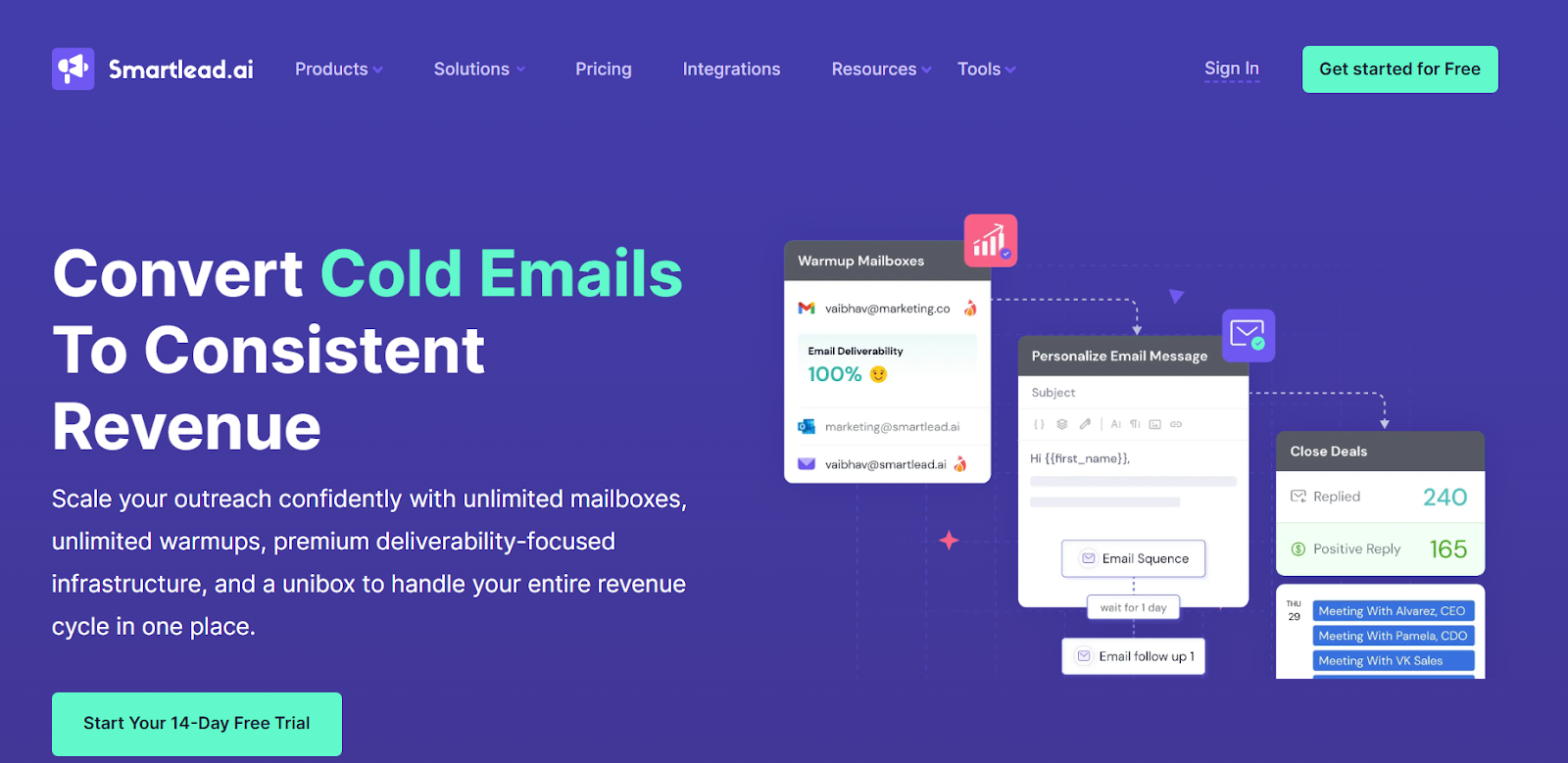
At one point during testing, I stopped worrying about fancy workflows or multi-source enrichment.
I just wanted my emails to get replies. That’s when I tested Smartlead.
Unlike Clay, which wants you to build things with data, Smartlead felt like it had one clear goal:
Send emails. Don’t land in spam. Do it at scale.
I connected a few inboxes, warmed them up using Smartlead’s AI engine, and launched a small outbound sequence. Smartlead enables automated outreach, making it easy to improve efficiency and scale campaigns.
And the best part? It worked without me needing to check every 5 minutes.
✅ What I Liked While Testing Smartlead:
- I signed up and connected multiple email accounts in under 10 minutes
- The AI-driven warm-up feature improved my email deliverability
- It has a centralized inbox, so I didn't have to switch between different tools
- The dashboard was super clean—no clutter, no confusion

⚠️ What’s Missing in Smartlead:
- It’s focused only on email performance — there’s no built-in lead generation or data enrichment
- No targeting filters — you can’t find leads based on title, industry, or company size like Apollo or Leadsforge
- Limited ability to personalize outreach — it works well for volume but does not offer advanced features to personalize outreach for highly tailored campaigns

💰 Smartlead Pricing (2025)

- Basic Plan – $39/month
- Pro Plan – $94/month
- Custom Plan – $174/month
Pricing is based on the number of leads per month. No free plan available.
If you're running cold outreach and want better email deliverability, Smartlead is a solid Clay alternative.
It's not for custom workflows, but if you just need emails to land in the inbox, it does the job really well.
Next up, I'll cover Clearbit.
5. Clearbit – Deep Enrichment, But Is It Worth the Price?

By the time I got to Clearbit, I’d already tested tools that focused on finding leads, sending emails, and warming up inboxes.
But Clearbit felt different — it doesn’t try to do everything. Its core offering is its data enrichment feature, which enhances your existing leads with solid company data. Clearbit connects and enriches diverse customer data sources to build unified profiles, enabling more effective segmentation.
I wanted to see if that focus was worth the price, and whether it could replace the enrichment blocks I’d been using inside Clay.
So I connected it to my CRM and let it run. No complicated flows, no browser extensions — it just started filling in the blanks automatically. Clearbit streamlines the sales process by automatically enriching CRM records and reducing manual data entry.
✅ What I Liked During Testing:
- The setup was fast. I connected it to my HubSpot CRM, and it started enriching records instantly. Clearbit integrates seamlessly with major CRM platforms like HubSpot and Salesforce.
- The data felt detailed — I got company size, industry, employee count, tech used, and more.
- It updates in real-time, so I didn’t have to keep re-uploading lists like I did with some other tools.

⚠️ What’s Missing in Clearbit:
- It’s enrichment-only. No outreach. No cold email sequences.
- It’s built more for sales teams working inside CRMs than for cold outbound campaigns.
- The pricing isn’t clear on the site, and when I asked for a quote, it felt more like enterprise-level. Costs can rise quickly if you require bulk data enrichment for large volumes of records.

💰 Clearbit Pricing (2025)
Clearbit doesn't share its pricing publicly.
Based on what I found during research and testing:
Most teams pay somewhere between $12,000 to $24,000 per year, depending on how much data they enrich and which features they use.
If you're using HubSpot, pricing may be bundled or adjusted based on your CRM usage.
The best way to get exact numbers is to request a custom quote or demo directly from their team.
There's no free plan anymore, and costs can rise quickly if you're enriching large volumes.
If you're part of a RevOps or CRM-heavy sales team, Clearbit is great for keeping lead data clean and current.
But if you want to build workflows, run outreach, or customize how data flows, Clay still gives you more control.
6. Floqer - Best for Enrichment-First Workflows
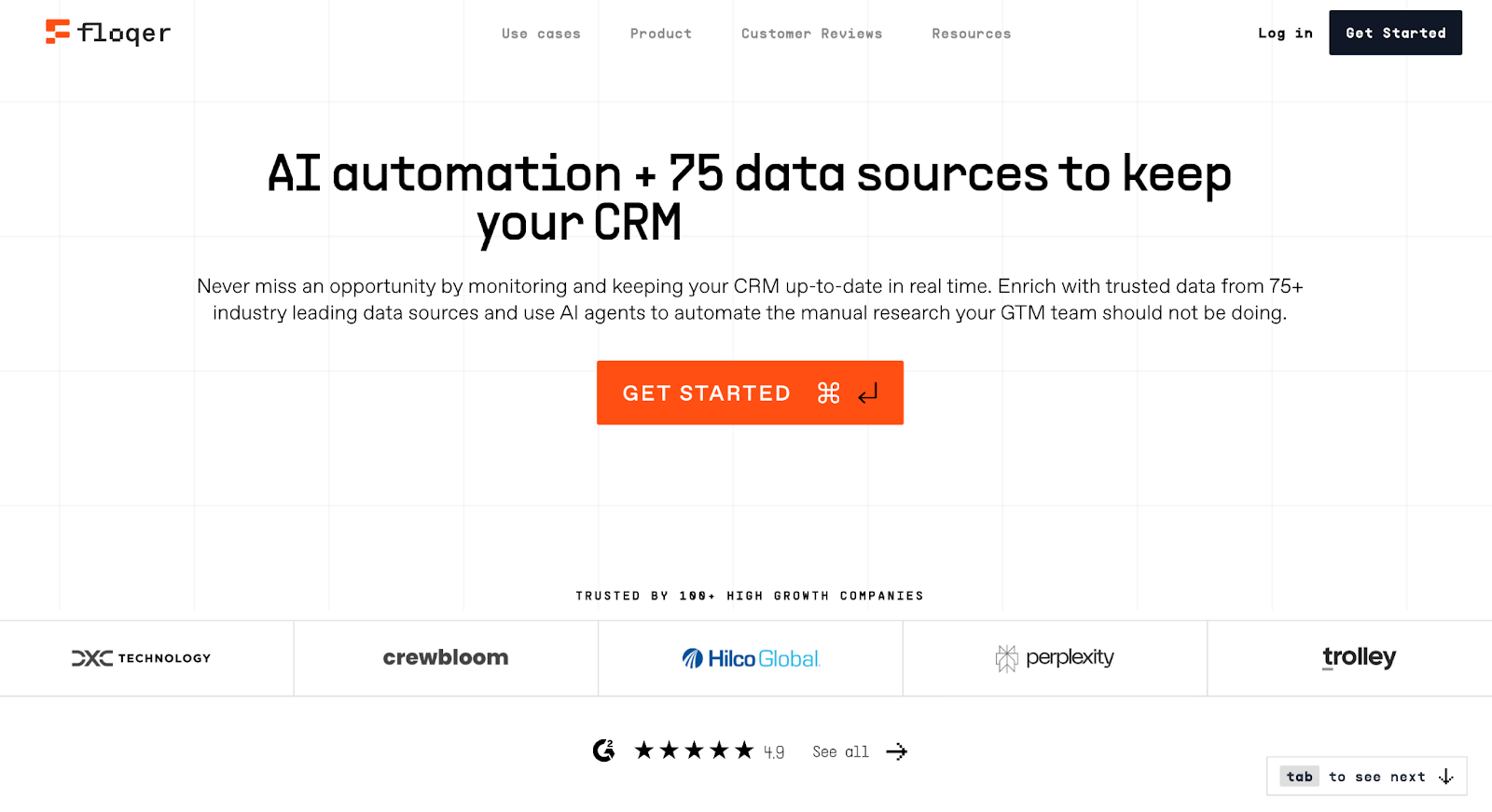
Floqer is built for enrichment-first workflows.
Unlike Clay, which often burns credits fast and requires multiple third-party tools, Floqer puts data + workflows + CRM sync into one place.
Floqer streamlines data management by combining enrichment, workflow automation, and CRM sync in a single platform. Floqer enables users to build automated workflows for enrichment and CRM sync, reducing manual effort and setup time.
It is a powerful sales intelligence platform that combines enrichment, workflow automation, and analytics for B2B sales teams.
With Clay, you can stitch sources together, but setup takes time, and the costs pile up.
With Floqer, I was able to build a clean workflow in under 30 minutes and the enrichment quality, especially for HR and Fintech contacts, was noticeably stronger.
✅ What I Liked While Testing Floqer:
- Pulled accurate HR, Fintech, and E-commerce contacts with enriched data, including up-to-date job titles and emails, better than Clay.
- No extra tools needed, Apollo data + SalesNav search were built in.
- The workflow builder felt like a mix of AirTable (clarity) + N8N (flexibility).
- The support team actually responded fast—unlike Clay’s slow, robotic replies.

⚠️ What’s Missing in Floqer:
- Smaller community right now, so fewer tutorials/resources than Clay.
- No outreach functionality — you’ll need to connect it with Outreach, Salesloft, or Apollo.
- The starting price is still premium compared to some lighter alternatives.

Floqer Pricing (2025)
No free plan, but overall 20–30% less than Clay for the same enrichment power.
- Starting price: $499/month
- Pricing depends on workflow complexity + data volume.
- Credits are cheaper and more transparent than Clay's.
If you're running enrichment-heavy GTM workflows and want Clay-level power without Clay's cost + complexity, Floqer is a strong alternative.
It won't replace your sequencer, but for data quality and workflows inside your CRM, it does the job really well.
7. Coldreach.ai – Better Intent-Signal Based Outreach
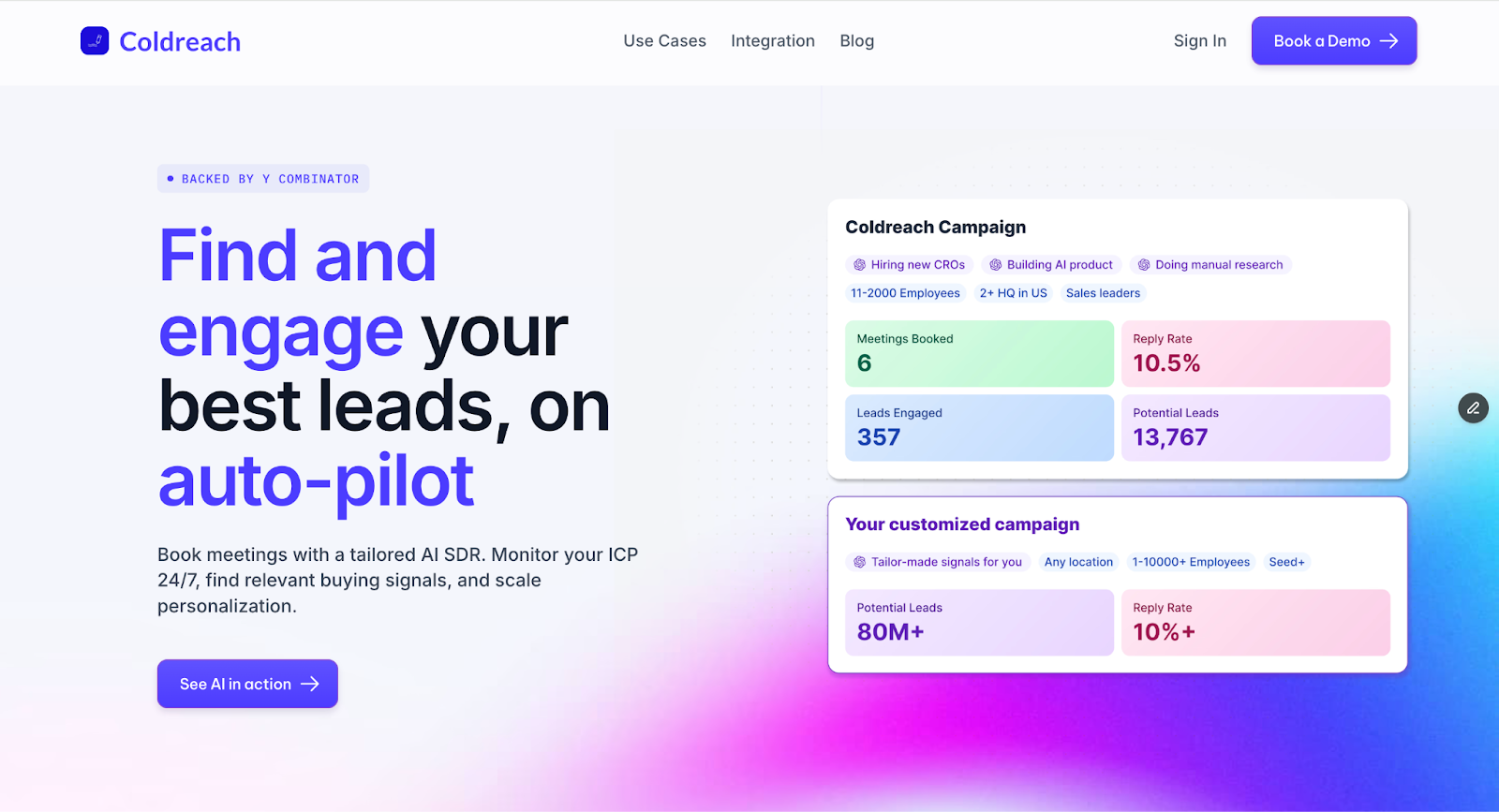
Coldreach isn’t built just for data pulls.
It’s designed to monitor your ICP 24/7, detect buying signals, and send personalized outreach to inboxes without requiring you to run the campaigns yourself.
Coldreach also leverages intent data to prioritize outreach and identify prospects who are actively showing buying signals. Coldreach leverages conversation intelligence to analyze prospect interactions across calls and emails, providing actionable insights to improve outreach strategies.
It also provides sales insights through analytics and performance metrics, helping teams refine their outreach. If applicable, Coldreach includes website visitor tracking to identify and engage anonymous leads.
While Clay helps you build enrichment workflows, Coldreach feels closer to having an SDR on payroll, but automated.
✅ What I Liked While Testing Coldreach.ai:
- Intent signals actually worked — it monitored accounts in real time and flagged when someone hit a trigger (like job changes).
- Personalization was built in — no exporting to another tool, the AI generated tailored emails directly.
- 24/7 monitoring — unlike tools where you run static lists, Coldreach kept your sales pipeline active by continuously tracking and engaging prospects.
- Setup was fast — I had an AI SDR running in a few minutes, without complex workflows.
⚠️ What’s Missing in Coldreach.ai:
- Less flexible than Clay if you want to design custom enrichment workflows.
- Works best for email, no native multi-channel like LinkedIn steps yet.
- Premium positioning, not the cheapest option if you’re a solo founder testing cold email for the first time.
💰 Coldreach Pricing (2025)
Pricing is based on the number of monitored accounts and AI SDR usage. No free plan, but you can book a demo to see tailored use cases.
If you want hands-off SDR coverage that continuously finds and engages leads, Coldreach is a solid alternative to Clay and Apollo.
It won't give you raw data tables like Clay, but if your priority is timing + personalization at scale, it does the job really well.
That wraps up the tool testing.
Now, I'll share how to choose the right one for your team, depending on your goals. Ready?
Additional Clay Alternatives Worth Considering
Beyond the main Clay alternatives covered above, there are several other sales intelligence tools that deserve a spot on your radar—especially if your team values data enrichment, data quality, and accurate contact data. These additional tools also support sales teams in developing and optimizing their sales strategies through enriched data and actionable insights.
Lusha stands out as a user-friendly sales intelligence platform that makes it easy for sales and marketing teams to quickly access accurate contact data and prospect information. Its intuitive interface allows users to find direct phone numbers and verified email addresses with minimal effort, making it a great fit for teams that need reliable data without a steep learning curve.
Seamless.ai offers real-time lead search and contact discovery, helping sales teams uncover new prospects and enrich their CRM data on the fly. Its robust data enrichment capabilities ensure that your contact data stays fresh and accurate, supporting more effective lead generation and personalized outreach.
FullContact takes a different approach by focusing on website visitor identification and lead enrichment. It transforms anonymous web traffic into detailed prospect profiles, giving marketing teams the insights they need to target high-intent visitors and improve conversion rates. With FullContact, you can enhance your sales intelligence and gain a deeper understanding of your audience.
When evaluating these and other tools, consider factors like data enrichment features, pricing structure, data accuracy, and the overall fit with your sales processes. Each platform offers unique strengths—whether it’s Lusha’s ease of use, Seamless.ai’s real-time enrichment, or FullContact’s visitor tracking and lead enrichment.
By exploring these additional Clay alternatives, sales and marketing teams can streamline their workflows, improve data quality, optimize their sales strategies, and gain a competitive edge in today’s data-driven landscape.
How To Choose the Right Clay Alternative for Your Team
After testing all five tools, one thing became clear:
No single Clay alternative does everything.
Each one solves a different problem — some are faster, some are cleaner, and some just keep things simple. Depending on your goals, different alternatives can enhance or streamline your outreach efforts by automating prospecting, enriching data, or prioritizing accounts to improve your sales engagement.
So if you’re still stuck on which one to pick, here’s how I’d break it down based on what you need right now.
I’ve laid out the real-world scenarios I faced while testing, and which tool actually worked best in each case.
🔍 Quick Match Guide
The real trick is figuring out what problem you want to solve first.
If you’re just getting started, go for speed and simplicity. If you're scaling, pick based on data control or deliverability priorities.
Final Verdict
After trying all five, one thing was clear:
Clay gives you power — but you’ll need time, setup, and a few extra tools to make it all work.
The tools I tested made things simpler:
- Leadsforge was the fastest — enriched leads in minutes
- Apollo.io gave me reach and precision at scale
- Instantly was easy and fast to launch cold emails
- Smartlead helped me fix inboxing without touching a thing
- Clearbit quietly enriched CRM records in the background
While these tools offer strong automation and enrichment features, manual research may still be required for the highest accuracy in certain cases.
✅ If you want full control and have the time, Clay still holds up.
🚀 But if you want to move fast and start sending today?
👉 Go with Leadsforge.
It’s the one I’d actually use again — no fluff, no setup headaches, just clean leads and real campaigns that work.
